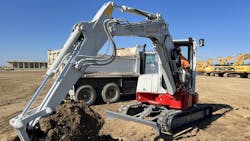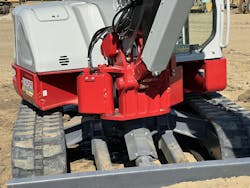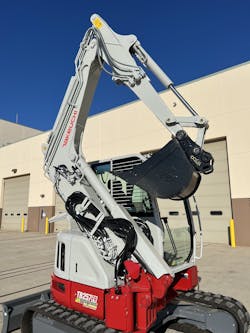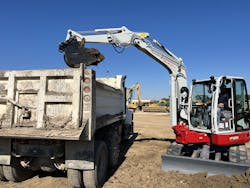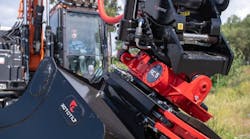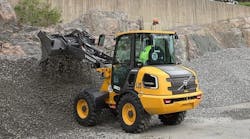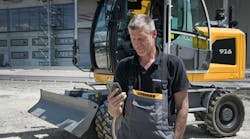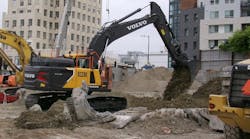The most noticeable feature on the Takeuchi TB257FR hydraulic excavator, a 5.7-metric-ton, 54-horsepower machine, is its patented side-to-side (STS) offset boom.
“It’s a one-piece boom instead of your standard knuckleboom on a machine like this,” said J.R. Boerner, territory account manager for Takeuchi’s Chicago-area dealer, McCann Industries. “It allows for the full rotation [hence the “FR”]. It’s got a long boom, a 9-foot stick, and this will give a dig depth of just over 12 feet 9 inches.”
The boom is heavy-duty and steel reinforced, Boerner says. There is a boom-holding valve and an overhead lift alarm.
The combination of the STS boom and a tight tail swing enables the excavator to fully rotate with very little overhang. That aims the TB257FR squarely at urban work, road and bridge construction, and other close-in applications.
It can dig offset over each track without having to be repositioned, and a low center of gravity and optimized counterweight is meant to create a stable platform with lifting capabilities comparable to a conventional unit, according to Takeuchi.
International Union of Operating Engineers Local 150 operator/instructors Chad Jeffries and “Dutch” Van Vuren wanted to find out how stable, how powerful, and how tightly the TB257FR could operate.
For this Construction Equipment Field Test, the duo would dig trenches, load trucks, backfill with the unit’s straight blade, and lift concrete manhole sections.
First, Boerner previewed the machine’s features.
“This unit has a standard straight blade,” he said. “We’ve got segmented hose on that; it’s a box-built, heavy-duty blade.”
The cylinder appears well protected with extra steel, and the blade itself has a heightened curvature for better material retention, something the operator/instructors would soon note.
“The blade has standard auto float,” Boerner said. “You can put that on from the joystick and it helps with final finish grade work.”
The control panel on the right side of the armrest features buttons for heavy lift and one-way auxiliary function, among others. The machine can run in ECO mode and high-altitude mode.
Two-way auxiliary hydraulics are standard, and it also comes with a hydraulic coupler circuit. The primary and secondary auxiliary circuits are plumbed to mid-arm and deliver up to 27.8 gpm of auxiliary flow. A third auxiliary circuit is available for use with a hydraulic coupler.
A 5.7-inch monitor allows control of the auxiliary functions, and operators can set programs specific to the attachments being used.
“This machine also has high flow, which you can run forestry heads on,” Boerner said.
“It comes standard thumb-ready,” he said. “On the tracks, we can do rubber, or we can do steel. It’s pre-drilled for the rubber street pads. We have triple-flange rollers and idlers so it makes good contact and you have less of a chance to roll the tracks off.”
Two points of contact at all times make the unit less susceptible to detracking.
At trenching time, the operator/instructors dug into hard soil off both the left and right sides of the tracks while only moving the boom. They would occasionally spin the housing and see that the machine can rotate almost entirely within its own tracks.
“The swivel [offset] that they’ve got built into this machine, I can see that coming in handy in tight alleyways where you don’t have any maneuverability, but you still have to get the job done,” said Jeffries.
“We were digging a box out there,” he said. “You want to start on the outsides of your box, so you’ve got equal pressure on your bucket, so instead of having to move the machine over to get a good straight line on that edge of the box, it’s easy to just swivel that housing over and get both of those sides cut in and work from the outside toward the middle.
“I like the way the boom and the dipper work; it doesn’t seem like they bleed any of the hydraulic power when you’re doing multiple functions at once,” Jeffries said.
Van Vuren was impressed with the visibility during digging. “When you rotated your boom, it’s great. I mean you can see everything. One side or the other is all good. I like the [offset] feature. There’s no problem seeing when you have a full bucket,” he said.
Both operators also tried a move Boerner suggested—pulling the bucket back parallel to the cab. This gives an already maneuverable machine even more space to turn or travel.
“When you’re on the right side, if you got a 30-inch or less bucket, that boom will come all the way back next to the cab,” Boerner said.
“It had pretty good visibility,” Van Vuren said. “The only thing I noticed when you have your arm all the way back past your cab, is looking through the glass on top of the roof. There isn’t quite enough visibility up there to see the top of a building. So, you have to lean forward a little bit and look out the top to see where you were at. If they made that [glass in the ceiling] a little bit bigger, it would be alright.”
Both operator/instructors tried the straight blade around their trenches.
“I like the fact that some of these smaller 9,000- and 10,000-pound machines, in some applications when you’ve got the blade in front of you, it’s nice to be able to actually use that and grab rock, or slag, or other material to force them into the smaller buckets,” Jeffries said.
“The way some of the boom angles are designed it makes it tough to get all the way back to the blade,” he said. “This one, I checked out a couple of different angles to see if it would be accessible to load something like rocks or slag into, and it makes it very comfortable to get all the way back to the blade to help you load a harder object into the bucket.
“Other models that I’ve run don’t offer the opportunity to actually get close enough to the blade without trying to kind of contort the way the boom and the dipper work together,” Jeffries said. “That’s a real nice feature of this one.”
Van Vuren homed in on the blade’s power.
“It felt really good, and it has the power,” he said. “When I got in that pile, it pushed that pile pretty good. I didn't hesitate one bit. Pushed it right in the hole. Some of the other equipment I've been running, when you're getting into a pile like that, it bogs them down, slows it way down. This one kept going.”
Next it was time to load the Local’s well-worn dump truck, which appeared to have an 8- or 9-foot clearance.
“The offset boom is a nice feature for loading trucks,” Van Vuren said. “In a small area or a tight area, you can tuck that boom all the way back and rotate around without hitting anything. You can load a truck pretty easily.”
Jeffries seemed to work the TB257FR extra hard on truck loading.
“[The 24-inch bucket] is the right-sized bucket for that machine,” he said. “You could start getting into some bigger buckets, a 42-inch ditching bucket, or a 36-inch bucket, which we have on some comparable machines here, but with that 2-foot bucket on that machine, you can put as much material in it as it will hold, and you can load right over the side.
“It’s good and stable,” Jeffries said. “You can reach out with the dipper if you’ve got a little bit taller truck and you have to get the dipper over the side. I went kind of high just to simulate what it would be like if I had a little taller truck with side rails on it.
“It didn’t seem to stress the machine at all,” Jeffries said. “Some of these machines, as you start to try and do multiple functions—you’re lifting the boom, you’re extending the dipper arm out, and you’re starting to dump the bucket all in one same motion—you start to see that you’re losing some power.”
Jeffries was impressed with the hydraulics overall.
“Maybe the boom isn’t coming up quite as fast as the dipper is, but I thought everything as far as the hydraulics and the pumps are tuned, everything seemed to work as it should,” he said. “As much pressure as you’re giving the levers is as much pressure is what you see in the reaction of the boom, the dipper, and the bucket all at the same time.”
The final test was lifting manhole components: a flat top that weighed 800 to 1,000 pounds, and a 36-inch cone/barrel section of 1,571 pounds.
The first piece was no problem, Van Vuren reported. The machine strained a bit working with the larger, heavier piece.
“She’s a little hesitant on extending that out,” he said. “Of course, you have the power to get it out there and bring it back, but it did better when it was closer to the machine. I didn’t feel any rocking, though, just that little drain on the hydraulics.”
The only criticism on the day was echoed by both operator instructors; although they liked the machine’s cab overall, they would like to see changes at their feet.
“I thought the cab comfort was pretty good, but I do think the think that maybe the foot pedals on it might be able to be adjusted a little bit,” Jeffries says. “It seems like you don’t have much space for your feet down there so when you have to flip, because they’re a hinged pedal, flip it down to go in reverse, maybe those could be loosened up a little bit. They seemed kind of tight to get them back down. Maybe they could be shortened up a little bit.”
Van Vuren agreed.
“The foot controls, they should have maybe adjusted those a little bit,” he said. “They’re extended out a little bit too far because you're cramped up down there.”
